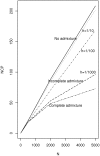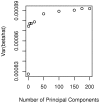The potential for enhancing the power of genetic association studies in African Americans through the reuse of existing genotype data
- PMID: 20824062
- PMCID: PMC2932740
- DOI: 10.1371/journal.pgen.1001096
The potential for enhancing the power of genetic association studies in African Americans through the reuse of existing genotype data
Abstract
We consider the feasibility of reusing existing control data obtained in genetic association studies in order to reduce costs for new studies. We discuss controlling for the population differences between cases and controls that are implicit in studies utilizing external control data. We give theoretical calculations of the statistical power of a test due to Bourgain et al (Am J Human Genet 2003), applied to the problem of dealing with case-control differences in genetic ancestry related to population isolation or population admixture. Theoretical results show that there may exist bounds for the non-centrality parameter for a test of association that places limits on study power even if sample sizes can grow arbitrarily large. We apply this method to data from a multi-center, geographically-diverse, genome-wide association study of breast cancer in African-American women. Our analysis of these data shows that admixture proportions differ by center with the average fraction of European admixture ranging from approximately 20% for participants from study sites in the Eastern United States to 25% for participants from West Coast sites. However, these differences in average admixture fraction between sites are largely counterbalanced by considerable diversity in individual admixture proportion within each study site. Our results suggest that statistical correction for admixture differences is feasible for future studies of African-Americans, utilizing the existing controls from the African-American Breast Cancer study, even if case ascertainment for the future studies is not balanced over the same centers or regions that supplied the controls for the current study.
Conflict of interest statement
The authors have declared that no competing interests exist.
Figures

 namely
namely  = 0.2 (solid line) and
= 0.2 (solid line) and  = 0.25 (dotted lines).
= 0.25 (dotted lines).
 as used in Figure 1.
as used in Figure 1.


 according to the number,
according to the number,  , of eigenvectors adjusted for in the Bourgain test of association.
, of eigenvectors adjusted for in the Bourgain test of association.
 .
.Similar articles
-
Genome-wide Significance Thresholds for Admixture Mapping Studies.Am J Hum Genet. 2019 Mar 7;104(3):454-465. doi: 10.1016/j.ajhg.2019.01.008. Epub 2019 Feb 14. Am J Hum Genet. 2019. PMID: 30773276 Free PMC article.
-
An ancestry informative marker panel design for individual ancestry estimation of Hispanic population using whole exome sequencing data.BMC Genomics. 2019 Dec 30;20(Suppl 12):1007. doi: 10.1186/s12864-019-6333-6. BMC Genomics. 2019. PMID: 31888480 Free PMC article.
-
Development of admixture mapping panels for African Americans from commercial high-density SNP arrays.BMC Genomics. 2010 Jul 5;11:417. doi: 10.1186/1471-2164-11-417. BMC Genomics. 2010. PMID: 20602785 Free PMC article.
-
Investigating the phenotypes and genotypes of breast cancer in women with African ancestry: the need for more genetic epidemiology.Surg Clin North Am. 2007 Apr;87(2):551-68, xii. doi: 10.1016/j.suc.2007.01.003. Surg Clin North Am. 2007. PMID: 17498544 Review.
-
Genetic admixture: a tool to identify diabetic nephropathy genes in African Americans.Ethn Dis. 2008 Summer;18(3):384-8. Ethn Dis. 2008. PMID: 18785456 Review.
Cited by
-
Red blood cell alloimmunization in sickle cell disease: listen to your ancestors.Transfus Med Hemother. 2014 Nov;41(6):431-5. doi: 10.1159/000369513. Epub 2014 Nov 14. Transfus Med Hemother. 2014. PMID: 25670930 Free PMC article. Review.
-
Exploring regional aspects of 3D facial variation within European individuals.Sci Rep. 2023 Mar 6;13(1):3708. doi: 10.1038/s41598-023-30855-x. Sci Rep. 2023. PMID: 36879022 Free PMC article.
-
Genetic epidemiology with a capital E: where will we be in another 10 years?Genet Epidemiol. 2012 Apr;36(3):179-82. doi: 10.1002/gepi.21612. Epub 2012 Feb 6. Genet Epidemiol. 2012. PMID: 22311722 Free PMC article.
-
Characterization of genetic loci that affect susceptibility to inflammatory bowel diseases in African Americans.Gastroenterology. 2015 Nov;149(6):1575-1586. doi: 10.1053/j.gastro.2015.07.065. Epub 2015 Aug 14. Gastroenterology. 2015. PMID: 26278503 Free PMC article.
-
The role of local ancestry adjustment in association studies using admixed populations.Genet Epidemiol. 2014 Sep;38(6):502-15. doi: 10.1002/gepi.21835. Epub 2014 Jul 15. Genet Epidemiol. 2014. PMID: 25043967 Free PMC article.
References
-
- Rothman KJ, Greenland S. Modern Epidemiology. Philadelphia: Lippincott-Raven; 1998.
-
- Rakovski CS, Stram DO. A kinship-based modification of the Armitage trend test to address hidden population structure and small differential genotyping errors. PLoS One. 2009;4:e5825. doi: 10.1371/journal.pone.0005825. - DOI - PMC - PubMed
-
- Astle W, Balding DJ. Population structure and cryptic relatedness in genetic association studies. Statistical Science. 2010 In press.
Publication types
MeSH terms
Grants and funding
- U01 CA069417/CA/NCI NIH HHS/United States
- R01-CA73629/CA/NCI NIH HHS/United States
- P30 ES010126/ES/NIEHS NIH HHS/United States
- P01 CA 017054-30/CA/NCI NIH HHS/United States
- R01-CA63464/CA/NCI NIH HHS/United States
- U01-CA69417/CA/NCI NIH HHS/United States
- R01 CA073629/CA/NCI NIH HHS/United States
- R01-CA100598/CA/NCI NIH HHS/United States
- R01 CA063464/CA/NCI NIH HHS/United States
- CA-06-503/CA/NCI NIH HHS/United States
- P01 CA017054/CA/NCI NIH HHS/United States
- R37 CA054281/CA/NCI NIH HHS/United States
- P50 CA058223/CA/NCI NIH HHS/United States
- P50-CA58223/CA/NCI NIH HHS/United States
- R01 CA100374/CA/NCI NIH HHS/United States
- R01-CA77305/CA/NCI NIH HHS/United States
- R01-CA100374/CA/NCI NIH HHS/United States
- R37-CA54281/CA/NCI NIH HHS/United States
- N01-HD-3-3175/HD/NICHD NIH HHS/United States
- P30-ES10126/ES/NIEHS NIH HHS/United States
- R01 CA100598/CA/NCI NIH HHS/United States
LinkOut - more resources
Full Text Sources
Molecular Biology Databases

